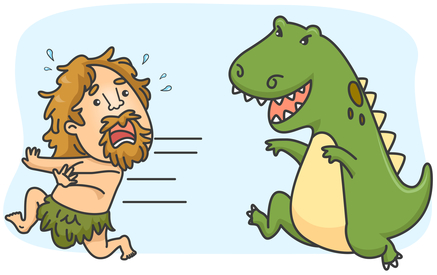Are You Scaring Your Customer’s Inner Caveman?
[Guest article by Liraz Margalit, PhD]
When it comes to improving online customer experience, your visitors are all cavemen.

Why is this important? Because marketers, from tiny entrepreneurs to global enterprises, can unintentionally trigger adverse behavior from visitors if they don’t take psychology into account.
All day long, we humans are trapped in an endless tussle for control of our surroundings, from the big things to minutiae. Since our days dwelling in caves, we crave control because it offers comfort.
When things feel out of our control, our bodies immediately respond. Our deep subconscious floods us with tension until we can remedy things.
This neurological response is the same regardless of the loss-of-control trigger.
Are You Scaring Your Customer's Inner Caveman? #CX #UX Share on XIf you lose control of a relationship or the buzz of your phone makes you lose control of a pleasant weekend moment, you’re likely to react in the same way.
Case Study: News Content
For businesses with websites, understanding the human need for control offers a powerful tool for enhancing customer experience. In my role as a web psychologist for ClickTale, I recently helped one of the world’s largest and most influential news organizations analyze customer behavior on their website. The news organization was trying to increase video content viewing by having video load automatically on their homepage.
The video in question was slick and well designed, and its content was interesting.
But, there was one aspect the organization hadn’t considered… when a visitor comes to a website planning to read the news but sound and video suddenly jump out at them, the effect is jarring. That surprise makes visitors feel they are losing control.
What we found when we analyzed the page was that visitors tended to always click on the “pause” button as soon as they encountered the video.
Pausing the video put the control of their experience back into the visitors’ own hands.
Automatically starting the video created the opposite reaction. It increased the probability that visitors would not watch the video at all. Instead, it encouraged them to read the text located below the video – not the desired outcome!
Auto-play videos may actually decrease video viewing #CX #UX Share on XThe Expectation Factor
This response can be explained by a psychological effect called the expectation factor.
People come into situations expecting to receive something specific. Expectation factors apply to all aspects of life. You go to a job interview and expect the hiring manager to ask certain questions. You go to a birthday party and expect to eat certain foods and have a certain level of fun.
It’s important for businesses to understand that, when customers visit their websites, the expectation factor is also very much at play.
If you present your visitors with an experience that strays too much from what they anticipate, they will end up feeling a loss of control. In response, they will do things to regain the feeling of control. They might click “pause” on a video or even exit the page entirely.
In order to manage this tussle over control between websites and visitors, it’s important to also understand the power of perceived control.
Visitors like to think they are in charge of their actions. When a video plays without visitors initiating any interaction, they feel the opposite.
If a visitor feels that a website is trying to “sell” him something, or push him into viewing certain content without his choosing to do so, he will push back by trying to take back the interaction and intentionally avoid that content. This occurs deep within our subconscious and triggers biochemical prods that are part of a primitive neurological mechanism.
Danger Cues
Why do we react so strongly to encountering a video playing automatically on a website or to a cell phone alarm going off in the middle of a quiet afternoon? The reasons, it turns out, are rooted in our deepest prehistoric history.
The first humans had to be constantly on alert for changes in their environment, because unexpected sounds or sights meant only one thing: danger.

When we click on a website hoping to read an article and instead are confronted with a loud, bright video, the automatic response is not so different from that our prehistoric ancestors, walking in the forest and stumbling upon a bear or a saber-toothed tiger.
Our body reacts first to eliminate the stressor in our midst. Then, because we have an inner need to make sure our thoughts and behaviors are consistent, we then subconsciously rationalize our decision.
“If I stopped the video, it must not be interesting,” you might think to yourself.
By forcing the video upon its visitors instead of letting them choose to click “play,” the news organization significantly decreased the chances readers would have any interest in watching it.
Other Stressors
Automatic videos are not the only online situations that promote stress responses. Visitors also start to feel control slipping from their hands when they encounter very long web pages, especially those that require endless scrolling.
I’ve witnessed visitors start scrolling along a page and suddenly realize they don’t know where they are anymore. It’s a thoroughly modern phenomenon but it evokes the same fear triggers that our ancestors felt when they were in a foreign environment and suddenly didn’t know how far they were from home.
Our prehistoric ancestors used trail markers in order to not get lost. And websites that understand human psychology can also do something similar, employing sticky navigation – website menus that move with the page as the visitor scrolls, “sticking” in place and always remaining visible – to keep visitors feeling in control.
Include sticky navigation on long pages to keep your users in control. #CX #UX Share on XOld reactions, new triggers
From an evolutionary standpoint, if we are in control of our environment, we have a better chance of survival. While our behavior adapts to changes all the time, our evolutionary roots continue to affect us.
Even though the threats have become less obvious and sometimes are not even real, our body will generate the same autonomic reactions in response to perceived or imagined threats. The need for control is rooted deeply within us and has a subconscious impact on our online behavior too.
To avoid these threat-driven behaviors, be sure that your website or mobile app:
- Doesn’t startle the user.
- Behaves in the way most users expect it to.
- Leaves the user in control at all times.
Liraz Margalit and your Neuromarketing host, Roger Dooley, are both customer experience keynote speakers who take a brain-based approach to improving CX.
